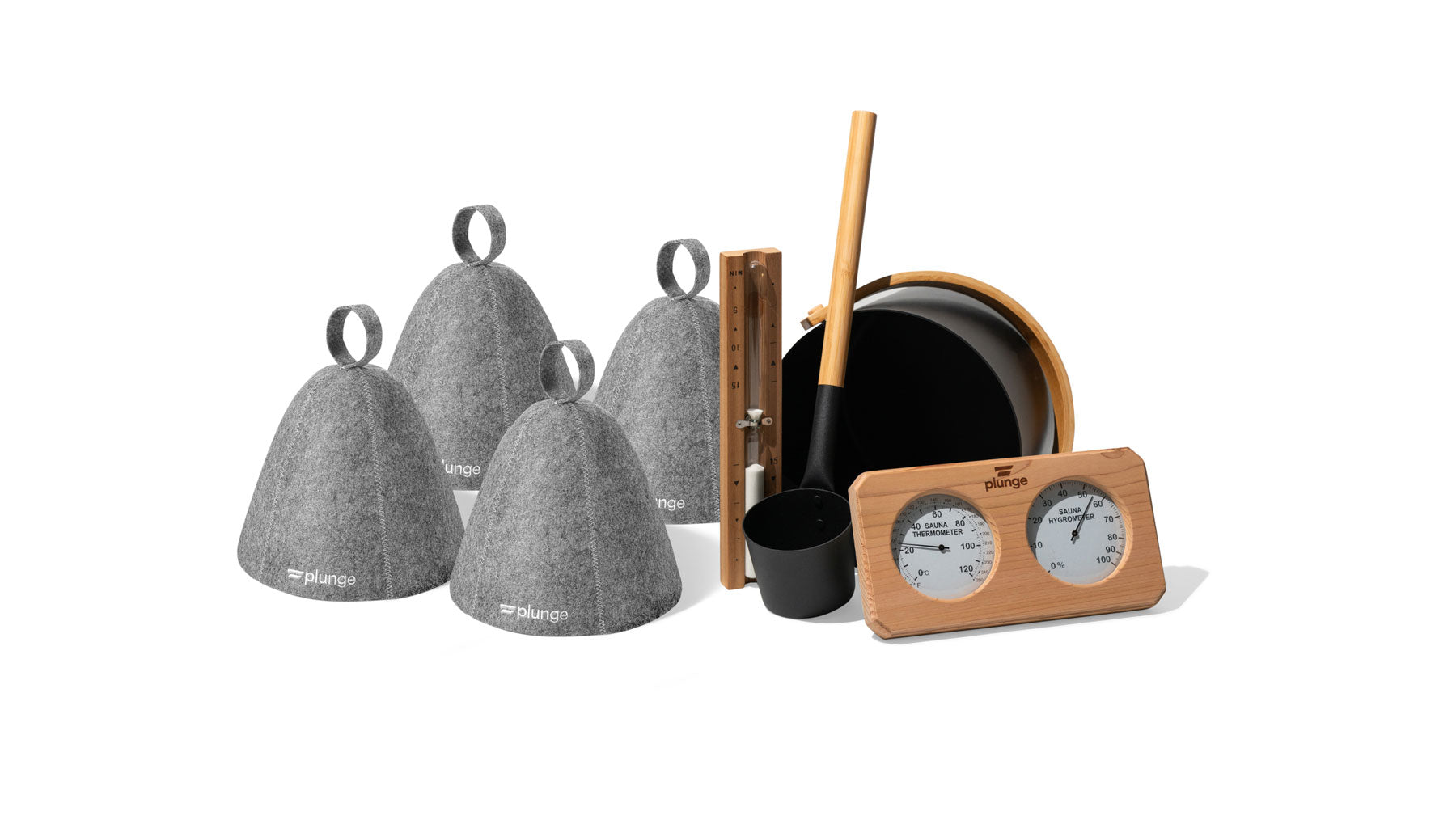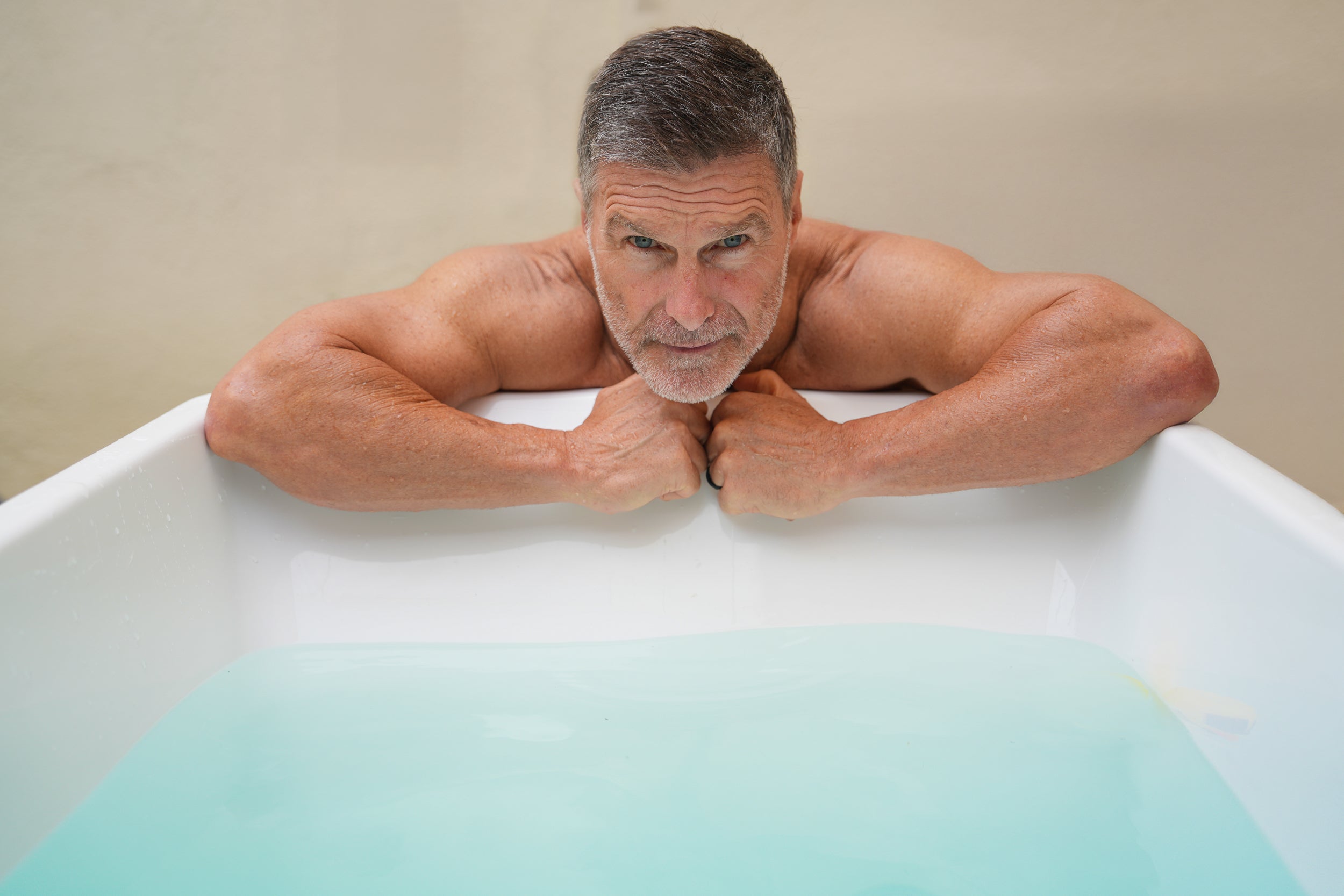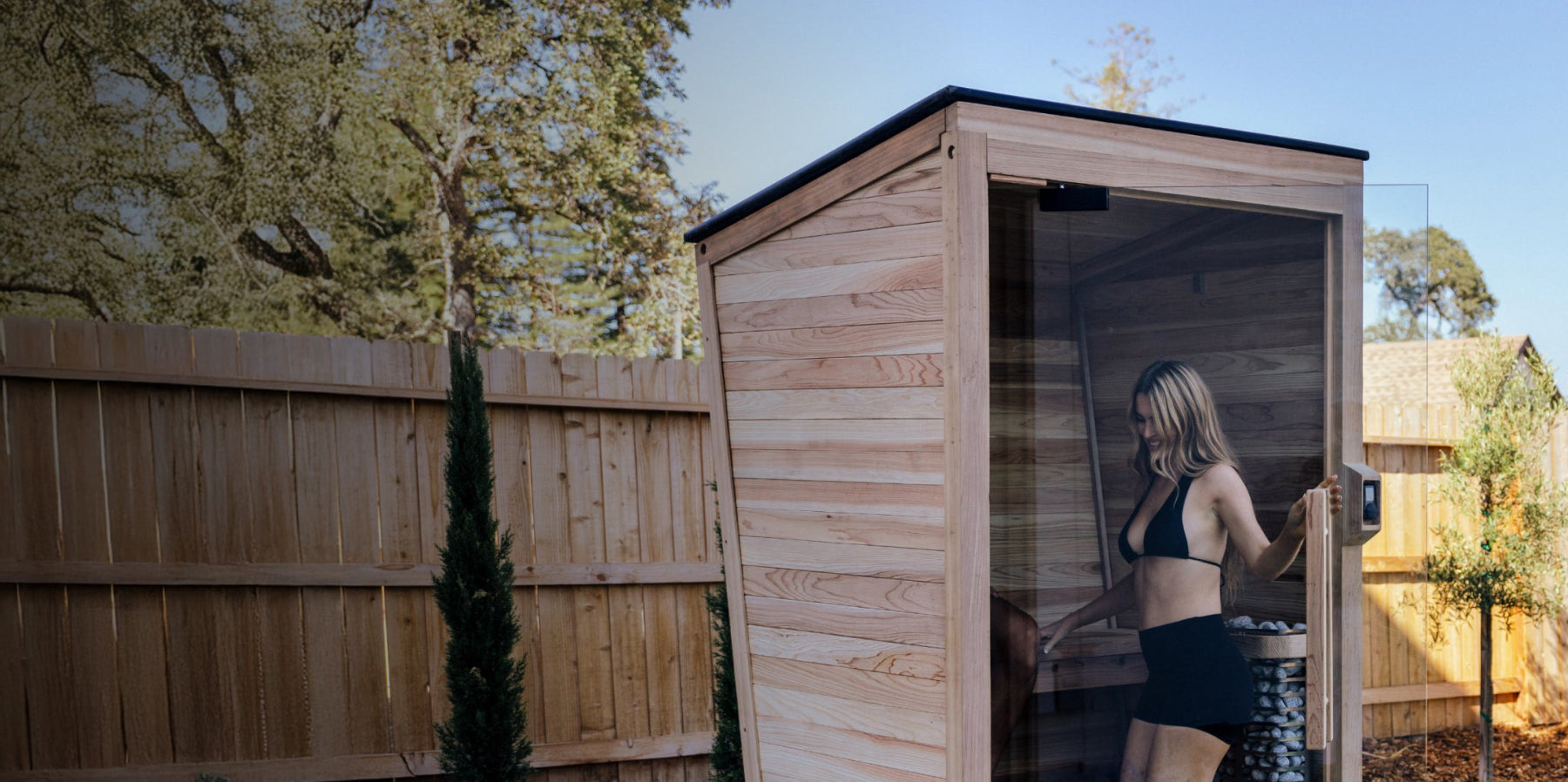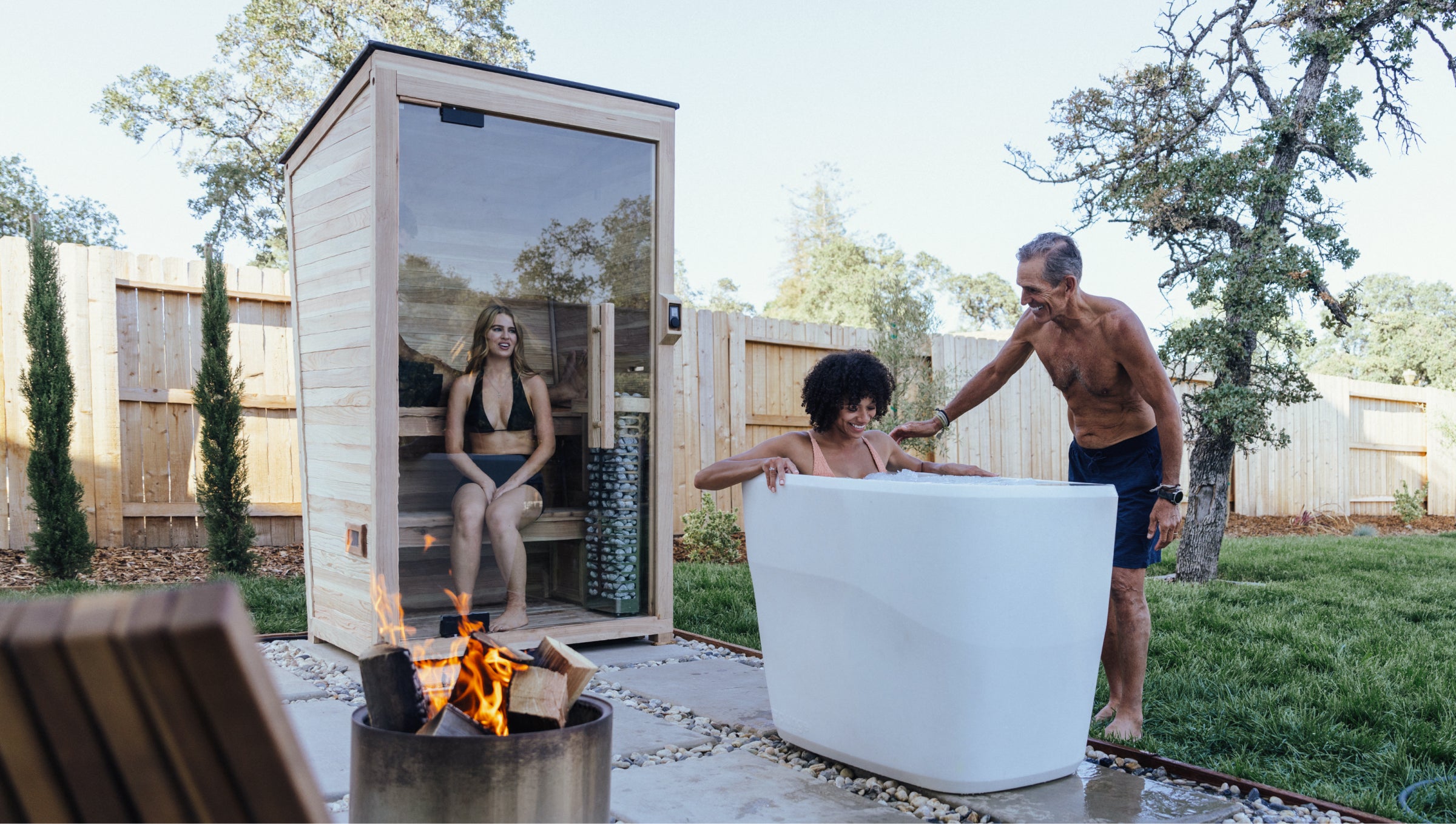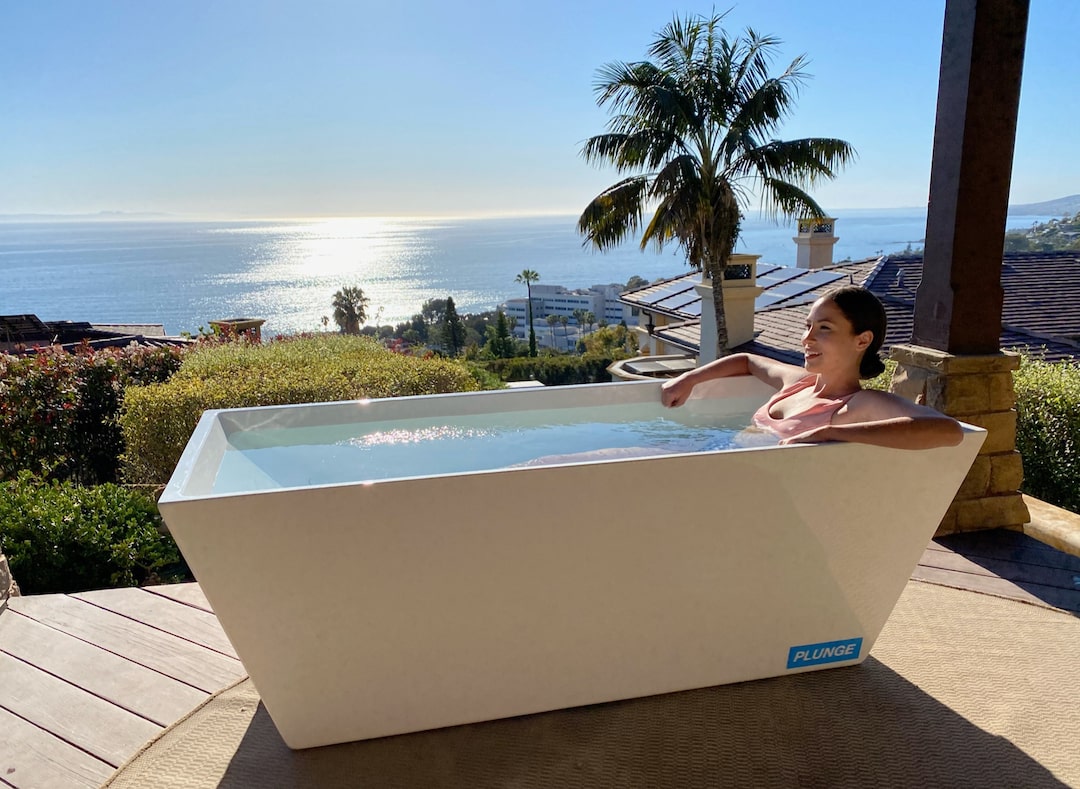
COLD PLUNGE BENEFITS: WHY DO PEOPLE TAKE ICE BATHS?
How do you wake up in the morning? A shot of espresso? 15 different alarm clocks? Everybody has their own method, but you might want to consider an unexpected option for your early morning wake-up needs: cold water therapy.
Cold therapy can be a cold shower after a long, hot day, an ice bath after a strenuous workout, or a morning cold plunge designed to help your mind and body reset, recover, and rejuvenate! Not only can cold plunging help you hit the ground running every morning, but it can also work to improve your overall health, putting you on the path towards becoming the best person you can be.
We’ve rounded up the best benefits of cold water therapy and why cold plunging might become your new favorite habit.
9 Cold Plunge Benefits
You might be wondering, what are the health benefits of ice baths? Well, the idea of using cold as a tool for therapy is nothing new. Going back to 3,500 B.C.E., humans have been using ice and cold to help treat injuries for millennia. As time has progressed, humans have found more and more benefits of cold therapy, eventually leading us to the relatively new trend of cold plunges.
There are plenty of reasons to add cold water therapy to your daily routine, but some of the biggest benefits include:
- Soothe Sore Muscles
- Support Your Immune System
- Builds Resilience
- Boosts Energy Levels
- Boost Your Metabolism
- Support Weight Loss
- Improve Your Mood and Support Mental Health
- Strengthen Your Hair And Skin
- Support Better Quality Sleep
Benefit #1: Soothe Sore Muscles
Just like throwing an ice pack on a sprained wrist, cold plunges can help reduce muscle soreness and sometimes decrease swelling and inflammation. Professional athletes and fitness buffs have been following this trend for a while, but don’t be intimidated — cold water therapy is truly for everyone.
When you submerge in cold water, your blood vessels will naturally constrict. Doing this diminishes your blood flow, which in turn reduces inflammation in muscles. While this can be great for dealing with injuries and minor tweaks, you don’t need to be hurt to benefit.
There is evidence to suggest that cold plunges can improve circulation, thanks to the same idea of constricting your blood vessels. When you first hit the cold water, the circulation on the surface of your body (your skin) constricts. To try and maintain your body temperature, the blood in your deeper tissues will circulate at a higher rate, improving general blood flow.
Benefit #2: Support Your Immune System
Your immune system is one of the most critical aspects of your body’s health, and cold water immersion may help improve it. So, while it’s probably not a great idea to hop in a cold tub the next time you get the sniffles, a regular routine of cold plunging may be able to help you fight off future illnesses.
Studies have shown that exposure to cold water and cold temperatures can have an “immunostimulating” effect, which is a fancy way of saying that cold therapy can help your immune response.
Exposure to cold water can trigger your lymphatic system, eliminating waste and toxins within the body. Lymphatic vessels, which carry infection-fighting white blood cells, will constrict when in contact with cold water, forcing the lymphatic system to pump. This, in turn, triggers your immune system, boosting your white blood cell count and improving your immune response!
Benefit #3: Builds Resilience
Voluntarily dipping your body into freezing water challenges you both physically and mentally, pushing your body past its comfort zone. It takes fortitude to withstand cold temperatures, even for a short time, which is why ice baths build up your resiliency. Building up a routine of cold plunging can even help you develop better self-control and gain more energy.
While hot tubs are known for their relaxation, cold tubs are notoriously difficult to get used to. Nothing can prepare you for the first shock of taking a cold plunge, and unless you’ve actively practiced the Wim Hof Cold Therapy Method, it might be challenging to get your routine started.
Sitting in chilled water acts as a physiological stressor and temporarily puts your body in survival mode. However, brief and repeated exposure to this physical stress may improve your overall stress response in a process called cross-adaptation. Your body adapts to repeated exposure to ice baths by building your defenses to have them in place in case the ice bath happens again.
Even if you’ve started a routine, it won’t feel much easier to get in the tub every day — but pushing through that initial discomfort can help you leap out of your comfort zone. Of course, it’ll take some work to convince yourself, but by sticking to your guns and pushing through your discomfort, you might find it more accessible and easier to master self-control.
Benefit #4: Boosts Energy Levels
You know that feeling of what it's like to be alive? Like, really alive in an energetic way? That's what plunging gives us.
Our co-founder, Michael, is more of a hypo-aroused person by nature and says, "The energy I get from plunging is so important for me. I wake up feeling lethargic most mornings, but after I plunge, I have a significant boost in energy."
Sticking to a cold plunge routine can also boost your energy levels, thanks to a hormone and neurotransmitter called norepinephrine. Norepinephrine in the brain helps to regulate focus, attention, and mood, and when we come into contact with cold water, there is a significant release of norepinephrine into our bodies.
This sudden increase stimulates our sympathetic nervous system, better known as our “fight-or-flight” response. Once this is triggered, we get a flood of energy as our body works through the physical stress of cold temperatures.
Benefit #5: Boost Your Metabolism
The metabolic rate is the rate at which your body uses energy to burn calories. Studies have shown that cold exposure kicks this rate into high gear—anywhere from 8% to 80% higher — as your body works to keep itself warm.
Though it may not feel like it, shivering generates heat. That heat production requires energy, which boosts your metabolism. An increase in metabolism from soaking in an ice bath may then lead to the next surprising benefit.
Benefit #6: Support Weight Loss
Your body gets the energy it needs to keep you warm in the cold from brown adipose tissue, or brown fat. Think of a wood-burning stove that’s used to warm up a room. The wood is the “brown fat,” and the fire is the “metabolism.”
Louisa Nicola, MMed, BSc says "As your body shivers and activates brown fat, it burns calories at an accelerated rate. This suggests that ice baths could aid in weight loss or help maintain a healthy weight as part of your overall health and wellness routine."
Benefit #7: Improve Your Mood and Support Mental Health
If your mood needs a pick-me-up, an ice bath may do the trick. After that initial gasp from the shock of cold water, many people begin to feel invigorated and clear-headed. You can thank the release of endorphins, the feel-good hormones, for that.
When your body senses cold, your sympathetic nervous system gets to work. That’s the part of your nervous system that regulates the “fight-or-flight” response, which involves the release of hormones, such as adrenaline and endorphins, to help you get away from a threat (or fight it). Your body perceives cold as a “threat” or stressor, which is why it works so hard to keep you warm and releases hormones that improve your mood and boost focus.
Benefit #8: Strengthen Your Hair And Skin
Cold water therapy doesn’t only do you good on the inside, it does you good on the outside, too. More specifically, it can help strengthen your hair and skin.
Your hair may benefit from ice baths because chilly water can flatten ruffled cuticles, leaving it shiny and help it retain moisture to prevent breakage.
And because cold constricts blood vessels, ice baths may temporarily reduce redness and puffiness in your face and tighten pores. In addition, it may soothe itchy, irritated skin on the face and the rest of the body.
For optimal results, always start and end your normal shower routine with cold water. Starting with hot water first will strip away your skin’s natural oils, leaving your skin feeling dry and tight.
Benefit #9: Support Better Quality Sleep
There are several reasons why cold water immersion supports better sleep. As we mentioned above, ice bathing relieves stress and improves your mood, making your sleep more peaceful.
Louisa again notes that "Taking an ice bath upon waking can stimulate the production of dopamine and norepinephrine, which are crucial for mood regulation, focus, and energy. This surge in neurotransmitters signals to your body that a new day has begun, helping you feel alert and ready. This clear start helps prepare your body for the day ahead and may facilitate a smoother transition into the evening, promoting better sleep."
Cautions of Cold Plunging
While there are many benefits of cold plunging, there are certain precautions and risks to be aware of. We’ve covered the do’s and don’ts of ice baths here, but the basics include:
- Plunge sober, as inebriation and intoxication can impair your balance, motor skills, and more — which could lead to a slip
- Breathe slowly to control your heart rate and avoid hyperventilation that may make you feel lightheaded
- Listen to your body and get out if you start to feel significant discomfort or pain, pushing yourself too cold or too long could result in hypothermia in extreme cases
- Be careful getting in and out of your tub, slippery surfaces combined with adrenaline or lightheadedness might cause slips
Take the Plunge Into At-Home Cold Water Therapy
With so many cold plunge benefits, from better mental health, sleep, beauty, and metabolism, to stress reduction and greater resiliency, there’s every reason to add cold therapy to your workout recovery routine or your general everyday routine. And it’s easier than you may think — learn more about getting started with cold therapy at home here.
If you’re ready to reap these benefits of cold plunging, we have a range of options to find the right fit for your recovery or daily wellness routine. From the Pop-Up to the All-In, our tubs feature powerful cooling, sanitation, and filtration systems that make them far superior to any other cold water tub or DIY ice bath on the market.
Not convinced? Read more of our reviews and see how cold plunging has helped people from all walks of life overcome challenges and boost their health and wellness journeys. We also offer financing options, and our products are HSA/FSA-eligible, so learn more about our cold plunge tubs today!
Meet the Experts
Louisa Nicola, MMed, BSc, attended Sydney Medical School and graduated with a particular interest in neurophysiology. She then founded Neuro Athletics, a multi-enterprise consulting firm that provides scientific strategies to help athletes and investors achieve peak performance.
Michael Garrett initially pursued a career in finance but soon realized that this was not his true passion. In 2012, he left his 9-5 job and spent 6 months in Southeast Asia before returning to the US to found Reboot Float & Cryo Spa in San Francisco. While on a van road trip through the Rocky Mountains, he developed a fondness for jumping into cold rivers and lakes, prompting him to create a DIY cold water setup back home and eventually founding Plunge in 2020 with fellow float center owner, Ryan Duey.
Medical Disclaimer: The information contained in this post is for informational and educational purposes only. It is not intended to provide medical advice or to take the place of such advice or treatment from a personal physician. While cold water therapy has many benefits, individual responses can vary, and the therapy may not be suitable for everyone.
References
Esperland, D., de Weerd, L., & Mercer, J. B. (2022). Health effects of voluntary exposure to cold water - a continuing subject of debate. International journal of circumpolar health, 81(1), 2111789. https://doi.org/10.1080/22423982.2022.2111789
Mooventhan, A., & Nivethitha, L. (2014). Scientific evidence-based effects of hydrotherapy on various systems of the body. North American journal of medical sciences, 6(5), 199–209. https://doi.org/10.4103/1947-2714.132935
Yeung, S. S., Ting, K. H., Hon, M., Fung, N. Y., Choi, M. M., Cheng, J. C., & Yeung, E. W. (2016). Effects of Cold Water Immersion on Muscle Oxygenation During Repeated Bouts of Fatiguing Exercise: A Randomized Controlled Study. Medicine, 95(1), e2455. https://doi.org/10.1097/MD.0000000000002455
Wang, H., Olivero, W., Wang, D., & Lanzino, G. (2006). Cold as a therapeutic agent. Acta neurochirurgica, 148(5), 565–570. https://doi.org/10.1007/s00701-006-0747-z
Tipton, M.J., Collier, N., Massey, H., Corbett, J. and Harper, M. (2017), Cold water immersion: kill or cure?. Exp Physiol, 102: 1335-1355. https://doi.org/10.1113/EP086283
Esperland, D., de Weerd, L., & Mercer, J. B. (2022). Health effects of voluntary exposure to cold water - a continuing subject of debate. International journal of circumpolar health, 81(1), 2111789. https://doi.org/10.1080/22423982.2022.2111789
Shevchuk N. A. (2008). Adapted cold shower as a potential treatment for depression. Medical hypotheses, 70(5), 995–1001. https://doi.org/10.1016/j.mehy.2007.04.052
Srámek, P., Simecková, M., Janský, L., Savlíková, J., & Vybíral, S. (2000). Human physiological responses to immersion into water of different temperatures. European journal of applied physiology, 81(5), 436–442. https://doi.org/10.1007/s004210050065
Cell Press. (2021, October 11). Winter-swimming Scandinavian men can teach us how the body adapts to extreme heat and cold. ScienceDaily. Retrieved June 6, 2024 from www.sciencedaily.com/releases/2021/10/211011110818.htm
Holloszy, J. O., & Smith, E. K. (1986). Longevity of cold-exposed rats: a reevaluation of the "rate-of-living theory". Journal of applied physiology (Bethesda, Md. : 1985), 61(5), 1656–1660. https://doi.org/10.1152/jappl.1986.61.5.1656
Peake JM, Markworth JF, Cumming KT, Aas SN, Roberts LA, Raastad T, Cameron-Smith D and Figueiredo VC (2020) The Effects of Cold Water Immersion and Active Recovery on Molecular Factors That Regulate Growth and Remodeling of Skeletal Muscle After Resistance Exercise. Front. Physiol. 11:737. doi: 10.3389/fphys.2020.00737
Liu, B., & Jordt, S. E. (2018). Cooling the Itch via TRPM8. The Journal of investigative dermatology, 138(6), 1254–1256. https://doi.org/10.1016/j.jid.2018.01.020
Yeung, S. S., Ting, K. H., Hon, M., Fung, N. Y., Choi, M. M., Cheng, J. C., & Yeung, E. W. (2016). Effects of Cold Water Immersion on Muscle Oxygenation During Repeated Bouts of Fatiguing Exercise: A Randomized Controlled Study. Medicine, 95(1), e2455. https://doi.org/10.1097/MD.0000000000002455
Fourtillan J. B. (2002). Role of melatonin in the induction and maintenance of sleep. Dialogues in clinical neuroscience, 4(4), 395–401. https://doi.org/10.31887/DCNS.2002.4.4/jbfourtillan
Mäkinen, T. M., Mäntysaari, M., Pääkkönen, T., Jokelainen, J., Palinkas, L. A., Hassi, J., Leppäluoto, J., Tahvanainen, K., & Rintamäki, H. (2008). Autonomic nervous function during whole-body cold exposure before and after cold acclimation. Aviation, space, and environmental medicine, 79(9), 875–882. https://doi.org/10.3357/asem.2235.2008







